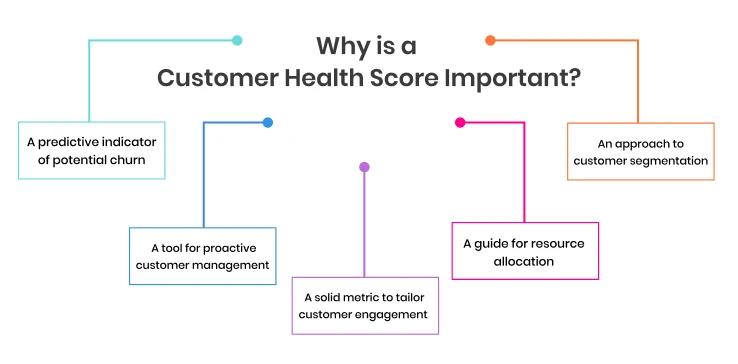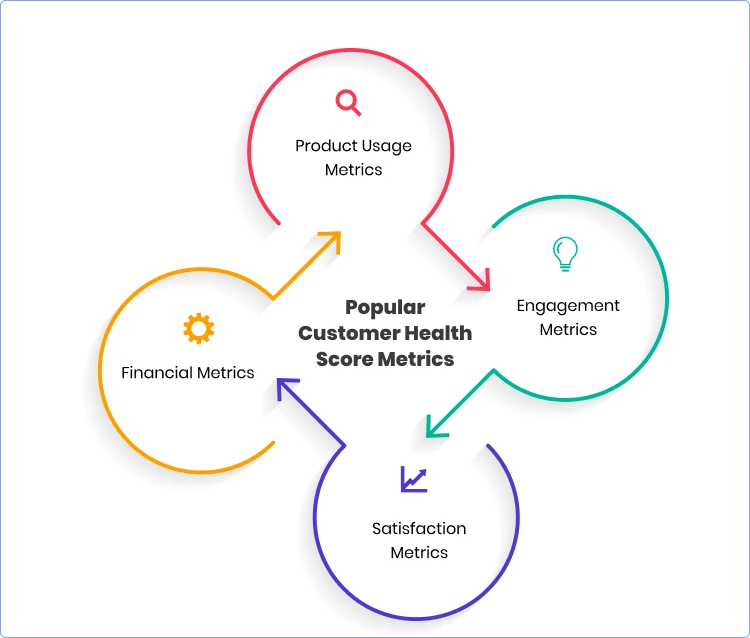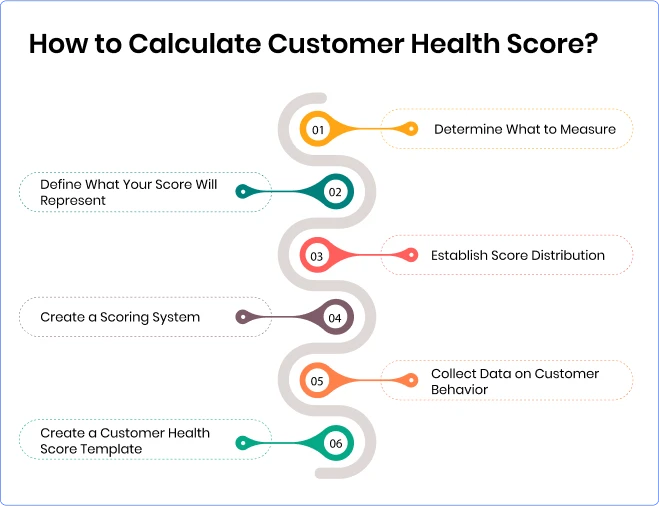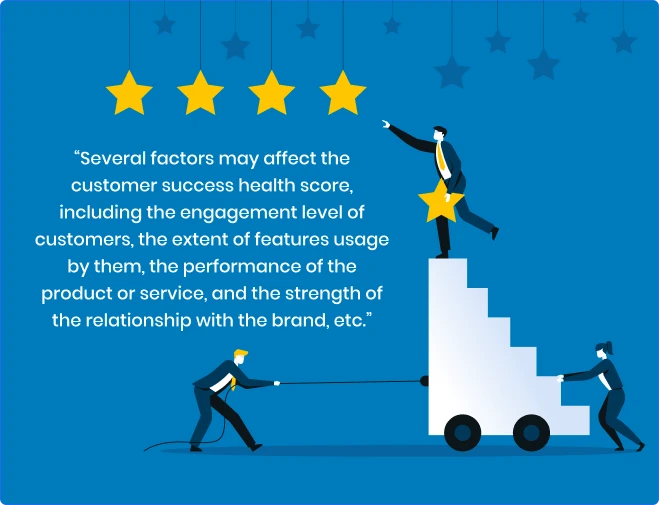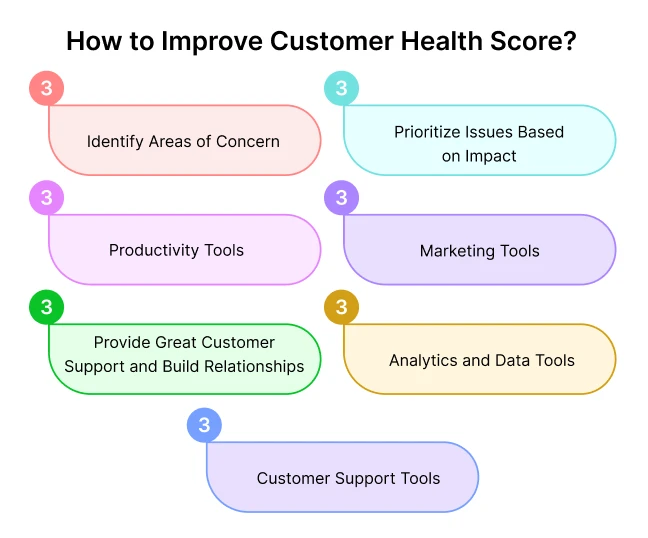Most businesses fear churn. They often worry about the situation when a valuable customer might wake up someday and decide to leave without giving any reason. Well, being worried won’t help much as it certainly can’t make customers stay. The key is to know the reasons and actions that may cause the churn. This is where a customer health score metric comes into the picture.
Tracking this metric can help you better understand the level of customer happiness with your product or service. It can also show the health score of your business at a particular point in time. If your business is healthy, chances are there will be a low churn rate and vice versa.
More so, a business that constantly tracks the customer health score can easily identify customers who are at risk of churning or disengaging. By proactively addressing churn issues, companies can improve retention rates and increase revenue or profitability.
In this blog, we will explore a customer health score in detail, understand its importance for companies, see some examples, and also look at the tips to increase it.
Before moving further, let’s first get started with the definition.
What is a Customer Health Score?
Customer health score is a helpful metric to measure the risk levels of a customer churn. It is a good indicator of a company’s robustness of relationships with the customer. When this score is low, it shows there are higher levels of risk of customer churn.

By tracking the customer health score metric, a business can understand ideal candidates for upselling. This score also prepares businesses to deploy their sales and marketing efforts where it matters more.
This metric is also essential for any business that cares to know whether a customer is planning to stay or leave their brand. The earlier customer success teams have this score, the more proactive steps they can take to minimize the dangers of churn.
Why is a Customer Health Score Important?
A business should consistently track its health score. Doing this can help it identify customers who are likely to go away. When this metric is not measured regularly, a business fails to know how healthily it’s managing customer relationships and ensuring success.
A customer health score is important for various reasons, including –
- A predictive indicator of potential churn – A health score is key to understanding customers’ loyalty or churn potential. It can serve as a good predictive indicator of the chances of customer stickiness or churn.
- A tool for proactive customer management – A low health score suggests that your customer is not feeling engaged with the brand or he/she is dissatisfied. Based on this information, a business can adopt proactive steps for customer management and fix the issues before they cause churn.
- A solid metric to tailor customer engagement – Health score is a useful metric to identify happy and unhappy customers. It will help you know whether customers need immediate support for their issues or whether they can be offered additional services or upgrades.
- A guide for resource allocation – A business always expects its resources to be used where they are most needed. This can help maximize the customer service and success efforts. To allocate the resources judiciously, a business needs a health score to know the customers they can prioritize.
- An approach to customer segmentation – Your business can use the customer health score metric to categorize customers into different groups. This will help in personalizing experiences based on the needs of each segment.
Key Customer Health Score Metrics
There is no specific formula to calculate a customer health score. Businesses that look to calculate it often rely on various metrics, specific to the nature of their industry and the unique customer needs. However, there are some key metrics that you need to measure customer health, and these are –
Product Usage Metrics
The way customers use products or services of a business is a good indicator of their level of satisfaction. Maybe that’s why a business can use various product usage metrics to measure its health score. These metrics may include the frequency rate of product usage, logins, sessions, interactions, and feature adoption rate.
Engagement Metrics
Engaged customers spend 67% more on average than new ones. This shows why customer engagement level is a very solid indicator of someone’s probability of sticking or leaving. Different engagement metrics are available that can be tracked to understand a customer health score. They include click-through rates, email open rates, response times, the number of tickets raised, etc.
Satisfaction Metrics
Happy and satisfied customers not only stick for longer but also spend more. Such types of customers are true assets for any business. That’s why it’s important to regularly track and measure key satisfaction metrics such as Net Promoter Score (NPS) or Customer Satisfaction Score (CSAT) to understand the level of happiness of your customers.
Financial Metrics
A business’ financial health improves when customers stay for a longer duration and purchase more. Such behavior is often reflected in the overall performance of the business. That’s why financial metrics such as renewal rates, revenue growth, and customer lifetime value (CLV) work as key metrics to measure the customer health score.
How to Calculate Customer Health Score?
Calculating a customer health score is easy if you have found the right metrics to track. The calculation will depend on the type of metrics you use and the type of business you operate. The key is to include both positive and negative indicators as it will give a detailed insight into the health of your customer.
Follow these steps to calculate a customer health score specific to your business –
1. Determine What to Measure
You need to analyze key indicators first if you want to determine the health of a customer. Determining what to measure is important as it will be unique to your business or product. Whatever you track should suggest the likelihood of your customer’s chances to upgrade or disengage. When you know what to measure, it can lead you to a unique and robust health score formula.
2. Define What Your Score Will Represent
Whatever score you achieve will indicate something about your customer health, either positively or negatively. The score will suggest whether you need to re-assess your customer effort and customer success strategy. Based on the kind of information you seek, you can monitor the relevant behavior metrics and accurately measure customer health at any specific point in time.
3. Establish Score Distribution
Make a list of all actions – both positive and negative – you want to consider for calculating the health score of your customer. You can consider separating both types of actions into two groups for clarity purposes. Based on the classification, you can add the positive actions to your score and subtract the negative ones. This is how you can get a specific score assigned to each action according to its weight or value.
4. Create a Scoring System
Creating a scoring system should be the next goal to get an overall score on the health of your customer. In this system, you can assign a score to each action based on their value addition to the business. If you think any action of the customer is good for the health of the business, you can show it on the positive side and vice versa.
5. Collect Data on Customer Behavior
The more customer data you have, the better insights you will gain on the health of your customers. That’s why you need to collect data on consumer behavior and habits to get an accurate picture of customer health. The data you have can help you put customers in different number ranges and set benchmarks.
6. Create a Customer Health Score Template
Having a template to measure customer health can prove helpful as everyone on the team can easily track the metric and become aware of the customer scenario. The template can effectively guide your customer success team. Similarly, you can create a customer health score dashboard where everyone can log in and see what’s going on at any point in time.
Factors Affecting the Customer Success Health Score
For businesses, it’s always a big challenge to develop a comprehensive understanding of a customer’s health. The task is complicated because several factors may affect the customer success health score. Once these factors are known, it becomes easy to take proactive steps and drive customer success with the business.
Some of the key factors affecting the customer success health score include –
- Whether the customer is using the full potential of the product or service is always a big determinant of their level of satisfaction with the business.
- The extent to which the various features or functionalities are used by the customer is also a big indicator of their happiness level.
- The levels of engagement with marketing materials and the depth of interactions with the support team are also good reflections of customer success with the business.
- The frequency to which a customer engages with educational resources can be a good determinant of their positive or negative perception of a brand.
- The kind of feedback a customer provides, whether in the form of reviews, testimonials, surveys, or ratings, can be a good judge of their health score.
- The overall reliability and performance of the product or service of a business can also be a big factor in making customers stick or leave.
- The strength of the relationship that the customer enjoys can also be a major aspect of their loyalty or disengagement with a brand.
- Whether a customer is happy or not can also be evaluated based on the frequency and quality of communication they have with the business.
- A business’s ability to meet customer needs and align values to specific goals can also impact the health score.
How to Improve Customer Health Score?
Keeping customers engaged and satisfied is a strategic approach that needs to be adopted to achieve growth for the business. That’s why the value of the customer health score metric grows manifold when a business uses it to improve the health of its customer relationships.
Here are different ways to improve the customer health score –
1. Identify Areas of Concern
A business first needs to identify the areas of concern before planning to improve them. Some areas may need more improvement than others, and some may need no improvement at all. Reviewing customer data and feedback could be the key to finding out areas where you need to improve. Evaluating support interactions can also be a good point to start when it comes to identifying weak areas.
2. Prioritize Issues based on Impact
Some issues may be critical and can impact the health of your customer more. If they are not addressed timely, they might push customers toward churn. However, some issues may not cause an immediate impact but might have a negative impact in the long run. So, you need to prioritize the most critical issues based on the level of impact they have on the customer, and the health of your business.
3. Focus on Enhancing Product Adoption by Customers
When customers are happy, they are more likely to fully optimize the features of your product or service. You can trust them to stick for longer based on the extent of product adoption. More so, their responses to your messages and communications are also a good signal of their immediate trust in your brand. That’s why you should always focus on encouraging customers to maximize the value of your offering.
4. Engage More with Customers
Engaged customers tend to be more trustful and less fidgety. The more engaged they are, the better relationships they form with the business. Such customers are also more receptive to price fluctuations in products or services. However, if they are not engaged, the likelihood of churn is not far away. 66% of consumers will abandon a brand if not engaged through personalized experiences.
That’s why your business should foster engagement through proactive and personalized communications with the customer. Make sure you collect regular feedback, attend to their queries promptly, and take steps to meet their needs.
5. Provide Great Customer Support and Build Relationships
Customers won’t go away anywhere if you provide great support to them, address their issues timely, and guide them through their problems. More so, you can win customers for life if you focus on building long-term relationships by aligning your business goals with theirs. But yes, always strive to offer the best quality of product and service as nothing else matters much if your offering does not meet customer’s expectations.
6. Talk to customers
If you’re not sure why your customer health score is low despite all your efforts, what would you do? Well, you can speak to customers and get a better understanding of the matter. Sending out satisfaction surveys can help, but up to a point only. The best way is to reach out to customers and ask them the reason why they are not scoring highly on various parameters you have set. You may also ask them about the steps and actions they expect of you.
7. Identify Patterns
All the customer data and insights you have gathered can be used to identify patterns of behavior. Those data could throw up some surprises as well on why some features are not getting the kind of traction you expected and so on. Maybe some features are not clicking with the customers for any reason beyond your understanding. The more you dig deep into the data, the more you can hope to find some patterns behind the low health score of the customer.
Customer Health Score Examples
Interpreting behavioral data and health scores is vital to gaining deep insights about customers. It helps us reach a meaningful conclusion about what customers like and what not. Some businesses are very good at turning the health score data into a decision-making tool.
Here are a few customer health score examples for you –
1. Percentage Scale
This scale is very simple to use and most businesses can adopt it for calculating their customer health scores. Whatever maximum value is assigned for a health score, the customer score can be divided by that value to get a percentage. Using this scale, a percentage score for each action can be calculated which eventually can help you exceed customer expectations.
2. Colour-Coding Scale
This scoring system may not be as precise as the percentage one, but it nonetheless is easy to use. Its working resembles that of a traffic light where the “red color” and “green color” have different meanings. Here too, the health score is assigned three values in color red, yellow, or green for easy understanding of their satisfaction level with the business.
3. Grading-Based Scale
As the name suggests, this scoring system assigns grades from F to A to a range of health scores. Excellent scores are rated A while poor ones are graded F, and the rating follows a top-down approach with the inferior ratings appearing higher and vice versa. The grading system makes it an easy method to understand the health score quickly.
Boost Customer Engagement and Achieve a Better Health Score with REVE
Engaged customers stay for longer, spend more, and have a higher CLV. Keeping this in mind, your business should focus more on engaging with customers more frequently and effectively.
At REVE, we bring you a wide range of engagement and support tools that you can use and serve your customers better.
You can use our AI-powered chatbot to increase the response rate and automate tasks across sales, marketing, and support.
You can also provide better visual support to customers by using our tools such as video chat software and co-browsing software.
Plus, we have advanced live chat software that you can add to the bot and elevate the level of customer support.
Final Thoughts
A business that strives for customer happiness enjoys better retention rates and lower churn. When customers are happy, they don’t feel the need to switch to competitors.
At REVE, we understand the significance of keeping customers engaged and serving them the best you possibly can.
That’s why our tools can be a great value addition to your customer engagement strategy. You can sign up and check the features of our products.

